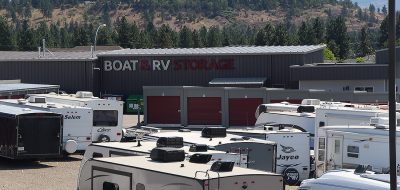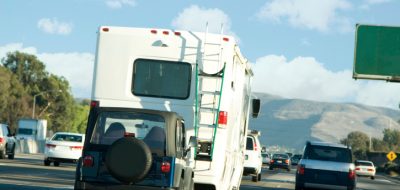Most recreational vehicle owners carry a cellular telephone now a days, or a P.D.A. (Personal Digital Assistant) like a Blackberry or similar device. Managing these while operating a motor home or pulling a large trailer can be a challenge. Particularly when dealing with where to store it and how to use it safely.
 It seems most dash boards today lack an area or location that would be suitable to store a phone. Fortunately, there are accessories available that can accomplish this on any vehicle configuration. Cellular phone and P.D.A. holders come in a variety of installation arrangements such as securing to a vent, screwing to the dash face, or suction cup mounts. However, there are other considerations when deciding the type of mount best for you. A secure mount is very important. The last thing you need while negotiating a winding mountain grade with a heavy vehicle, or vehicle combination, is your phone to go flying across the rig and onto the floor. The mount also must be within a comfortable reach of the driver.
It seems most dash boards today lack an area or location that would be suitable to store a phone. Fortunately, there are accessories available that can accomplish this on any vehicle configuration. Cellular phone and P.D.A. holders come in a variety of installation arrangements such as securing to a vent, screwing to the dash face, or suction cup mounts. However, there are other considerations when deciding the type of mount best for you. A secure mount is very important. The last thing you need while negotiating a winding mountain grade with a heavy vehicle, or vehicle combination, is your phone to go flying across the rig and onto the floor. The mount also must be within a comfortable reach of the driver.
 So, what is the best choice to meet these requirements? Well, in most cases, the placement anywhere on the dash face within a reasonable distance from the driver is not possible without obstructing something else, like a gauge or a control. In my opinion, there are two choices here; a good quality suction mount or a simple on-the-dash non-skid pad. A top quality suction cup base, like the German made one shown in the photo, is easy to install on most surfaces such as a window glass, dash top or dash face. It will hold fast for years through freezing temperatures to scorching hot sunshine, yet can be removed in seconds. It can be installed on a textured dash top if required, by using the supplied stick-on adaptor. The second choice, the use of an inexpensive non-skid dash pad, also works well. It will not only hold a phone but could be used for a variety of items. These pads, like the one depicted in the photo, do a remarkable job of holding all kinds of items, even during rough road conditions or hard brake applications.
So, what is the best choice to meet these requirements? Well, in most cases, the placement anywhere on the dash face within a reasonable distance from the driver is not possible without obstructing something else, like a gauge or a control. In my opinion, there are two choices here; a good quality suction mount or a simple on-the-dash non-skid pad. A top quality suction cup base, like the German made one shown in the photo, is easy to install on most surfaces such as a window glass, dash top or dash face. It will hold fast for years through freezing temperatures to scorching hot sunshine, yet can be removed in seconds. It can be installed on a textured dash top if required, by using the supplied stick-on adaptor. The second choice, the use of an inexpensive non-skid dash pad, also works well. It will not only hold a phone but could be used for a variety of items. These pads, like the one depicted in the photo, do a remarkable job of holding all kinds of items, even during rough road conditions or hard brake applications.
Okay, we have secured the communication device within reach of the driver, now how can we use it safely? Well, if you want to use it while driving, we had better look at both a safe and legal method of doing that. Safe, being a way to use it and keep both hands free to drive. And legal, being able to meet current and future laws forbidding the use of non-hands free cellular phones. These depend on the laws in your current geographic location. For this purpose there are wired and wireless headsets, stand-alone wireless modules and integrated wireless interfaces. The wired type of headset is available in many shapes, sizes and configurations and is relatively inexpensive. It is basically just a unit that plugs into the handset and tethers to a combination microphone/ear piece or more traditional boom microphone headset. The wireless type uses a technology called Bluetooth. Bluetooth transmits and receives between your handset and the listening device on frequencies separate to that of your cell service. This wireless communication between your phone and audio device only operates providing they are with 30 feet or so of each other, and unlike that of your network provider, transmits wirelessly without additional charges.
 Some people do not like to wear ear pieces or like headgear. For those people, here are three popular choices. First, some cellular handsets are capable of operating in a speaker phone mode. These units can be used absolutely hands free once the initial call has been placed or answered. The second option is a stand alone rechargeable audio module like the Motorola T505. These units are built to receive and transmit via Bluetooth to your handset. They have a built-in microphone and a speaker to allow full hands free operation. The T505 has an additional feature that will integrate with an FM radio should it be desired. When used in that mode it selects and announces the FM channel, or frequency to dial to. Additional audio announcing includes caller I.D. as well in either mode. This then drives all the incoming audio through the existing vehicle speakers mimicking that of General Motors OnStar system. It works well.
Some people do not like to wear ear pieces or like headgear. For those people, here are three popular choices. First, some cellular handsets are capable of operating in a speaker phone mode. These units can be used absolutely hands free once the initial call has been placed or answered. The second option is a stand alone rechargeable audio module like the Motorola T505. These units are built to receive and transmit via Bluetooth to your handset. They have a built-in microphone and a speaker to allow full hands free operation. The T505 has an additional feature that will integrate with an FM radio should it be desired. When used in that mode it selects and announces the FM channel, or frequency to dial to. Additional audio announcing includes caller I.D. as well in either mode. This then drives all the incoming audio through the existing vehicle speakers mimicking that of General Motors OnStar system. It works well.
The final choice is to have a Bluetooth receiver connected to your in-dash radio if the set is capable of such input. These are relatively easy to install on a radio that allows that option as it is basically a plug-n-play unit. Many of these installations on an LCD screen equipped radio include such things as touch screen dialing, visual call I.D. and auto contact transferring, to name a few. These also allow crystal clear communications through your existing in-dash audio system.
Of course there are other alternatives to managing your cellular communications while travelling. You can elect to turn the ringer down and check for messages occasionally throughout the day. This way the calls could be returned at your convenience from a rest stop or camp later that day. For this purpose a suitable message could be recorded outlining your return call activities such as “Hi, I’m currently travelling and unable to answer or respond to your call. Please leave a message and I will call you back later in the day.” Additionally, you can elect to carry your communication device on your belt, in your pocket or elsewhere within your vehicle if immediate answering is not required or wanted.
These are some relatively inexpensive ways that may make your travels safer and more enjoyable. Additionally, they make your vehicle just a little more customized for your particular needs.
Just Communicating Some Ideas – Lug_Nut – Peter Mercer





Lug_Nut
Joseph Kleinsmith, That sounds interesting and affective. Thank you for your input.
Joseph Kleinsmith
To keep my cell phone and sound system remote close at hand while driving, they sit on the cross bar (spoke) of my steering wheel held in place with a strip of velcro. Removal is easy and I don’t worry about them bouncing or sliding around on a dash mat or in a caddy. By applying a small strip of velcro to the table along my bed, I easily find my cell in the dark along with the tv, a/c & heater remotes.